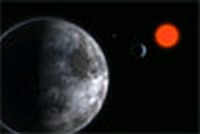Login form
Science
Super Earth
 An Earth-like planet spotted outside our solar system is the first found that could support liquid water and harbor life, scientists announced today. Liquid water is a key ingredient for life as we know it. The newfound planet is located at the "Goldilocks" distance-not too close and not too far from its star to keep water on its surface from freezing or vaporizing away.And while astronomers are not yet able to look for signs of biology on the planet, the discovery is a milestone in planet detection and the search for extraterrestrial life, one with the potential to profoundly change our outlook on the universe.The goal is to find life on a planet like the Earth around a star like the Sun. This is a step in that direction.Each time you go one step forward you are very happy.
An Earth-like planet spotted outside our solar system is the first found that could support liquid water and harbor life, scientists announced today. Liquid water is a key ingredient for life as we know it. The newfound planet is located at the "Goldilocks" distance-not too close and not too far from its star to keep water on its surface from freezing or vaporizing away.And while astronomers are not yet able to look for signs of biology on the planet, the discovery is a milestone in planet detection and the search for extraterrestrial life, one with the potential to profoundly change our outlook on the universe.The goal is to find life on a planet like the Earth around a star like the Sun. This is a step in that direction.Each time you go one step forward you are very happy.
Bird migration
 Bird migration refers to the regular seasonal journeys undertaken by many species of birds. Migrations include movements of varied distances made in response to changes in food availability, habitat or weather. These however are usually irregular or in only one direction and are termed variously as nomadism, invasions or irruptions. Migration is marked by its annual seasonality. In contrast, birds that are non-migratory are known as resident birds.
Bird migration refers to the regular seasonal journeys undertaken by many species of birds. Migrations include movements of varied distances made in response to changes in food availability, habitat or weather. These however are usually irregular or in only one direction and are termed variously as nomadism, invasions or irruptions. Migration is marked by its annual seasonality. In contrast, birds that are non-migratory are known as resident birds.
A simple explanation is food and a safe place to breed. Birds which breed in the summer in the extreme north such as the Arctic benefit from an abundance of food as plants and insect life flourish in the long daylight hours; and because few large permanent predators can survive the harsh winter.
The missing continent – ATLANTIS
 For those who don't know, the story of Atlantis is one of the oldest stories known to man. We believe it's in excess of 8,000 years old but quite frankly we only have to guess, because it wasn't written down till Plato got ahold of it and made it into an Greek Summer Blockbuster back in the year 360BC.You see Atlantis is such an important myth to understand because after Atlantis sank, it's residents and descendants fanned out into Europe and built a remarkable world using Atlantean technology. The Sphinx's and Pyramids, and not just Egyptian, but Mayan temples, and structures throughout the world were because of the remarkable, technological advancements of the Atlanteans. We still don't understand how such feats were capable. Perhaps Atlanteans had far greater technology then even we do today.
For those who don't know, the story of Atlantis is one of the oldest stories known to man. We believe it's in excess of 8,000 years old but quite frankly we only have to guess, because it wasn't written down till Plato got ahold of it and made it into an Greek Summer Blockbuster back in the year 360BC.You see Atlantis is such an important myth to understand because after Atlantis sank, it's residents and descendants fanned out into Europe and built a remarkable world using Atlantean technology. The Sphinx's and Pyramids, and not just Egyptian, but Mayan temples, and structures throughout the world were because of the remarkable, technological advancements of the Atlanteans. We still don't understand how such feats were capable. Perhaps Atlanteans had far greater technology then even we do today.
Spontaneous Human Combustion – SHC
 Spontaneous human combustion (SHC) refers to the belief that the human body sometimes burns without an external source of ignition. There is much speculation and controversy regarding SHC, for it is not a proven natural phenomenon. Many theories and hypotheses have attempted to explain how SHC might occur, but those which rely on current scientific understanding say that instances mistaken for spontaneous combustion actually required a source of ignition. One such hypothesis is the "wick effect", in which the clothing of the victim soaks up melted human fat and acts like the wick of a candle. Another possibility is that the clothing is caused to burn by a discharge of static electricity. The likelihood that truly spontaneous human combustion actually takes place is remote, due to the presence of water and the lack of highly flammable compounds and oxygen in the human body.
Spontaneous human combustion (SHC) refers to the belief that the human body sometimes burns without an external source of ignition. There is much speculation and controversy regarding SHC, for it is not a proven natural phenomenon. Many theories and hypotheses have attempted to explain how SHC might occur, but those which rely on current scientific understanding say that instances mistaken for spontaneous combustion actually required a source of ignition. One such hypothesis is the "wick effect", in which the clothing of the victim soaks up melted human fat and acts like the wick of a candle. Another possibility is that the clothing is caused to burn by a discharge of static electricity. The likelihood that truly spontaneous human combustion actually takes place is remote, due to the presence of water and the lack of highly flammable compounds and oxygen in the human body.
Galaxies
 Galaxy, a massive ensemble of hundreds of millions of stars, all gravitationally interacting, and orbiting about a common center. Astronomers estimate that there are about 125 billion galaxies in the universe. All the stars visible to the unaided eye from Earth belong to Earth’s galaxy, the Milky Way. The Sun, with its associated planets, is just one star in this galaxy. Besides stars and planets, galaxies contain clusters of stars; atomic hydrogen gas; molecular hydrogen; complex molecules composed of hydrogen, nitrogen, carbon, and silicon, among others; and cosmic rays.
Galaxy, a massive ensemble of hundreds of millions of stars, all gravitationally interacting, and orbiting about a common center. Astronomers estimate that there are about 125 billion galaxies in the universe. All the stars visible to the unaided eye from Earth belong to Earth’s galaxy, the Milky Way. The Sun, with its associated planets, is just one star in this galaxy. Besides stars and planets, galaxies contain clusters of stars; atomic hydrogen gas; molecular hydrogen; complex molecules composed of hydrogen, nitrogen, carbon, and silicon, among others; and cosmic rays.
Origins of Galaxies:
As the 21st century began, astronomers believed they were much closer to understanding the origins of galaxies.
